Financial Decision Making Report: SKANSKA PLC Performance Analysis
VerifiedAdded on 2023/01/09
|12
|3915
|74
Report
AI Summary
This report provides a comprehensive analysis of financial decision-making within SKANSKA PLC, a leading UK building projects company. The introduction highlights the significance of financial decisions for corporate progress and the importance of effective financial management. The main body of the report is divided into two tasks. Task 1 examines the roles and responsibilities of the accounting and finance departments, detailing their functions and duties such as bookkeeping, payroll, cash management, budgeting, and investment management. Task 2 focuses on the computation and interpretation of key financial ratios, including ROCE, net profit margin, current ratio, debtor and creditor collection periods, to evaluate SKANSKA PLC's performance in 2018 and 2019. The report concludes with an overview of the company's financial health based on these ratios, providing insights into its profitability, liquidity, and efficiency. This assignment is a valuable resource for students studying finance, offering a practical application of financial analysis techniques.

Financial Decision
Making
Making
Paraphrase This Document
Need a fresh take? Get an instant paraphrase of this document with our AI Paraphraser

Contents
INTRODUCTION...........................................................................................................................3
MAIN BODY..................................................................................................................................3
TASK 1............................................................................................................................................3
TASK 2............................................................................................................................................7
CONCLUSION..............................................................................................................................11
REFERENCES..............................................................................................................................12
INTRODUCTION...........................................................................................................................3
MAIN BODY..................................................................................................................................3
TASK 1............................................................................................................................................3
TASK 2............................................................................................................................................7
CONCLUSION..............................................................................................................................11
REFERENCES..............................................................................................................................12
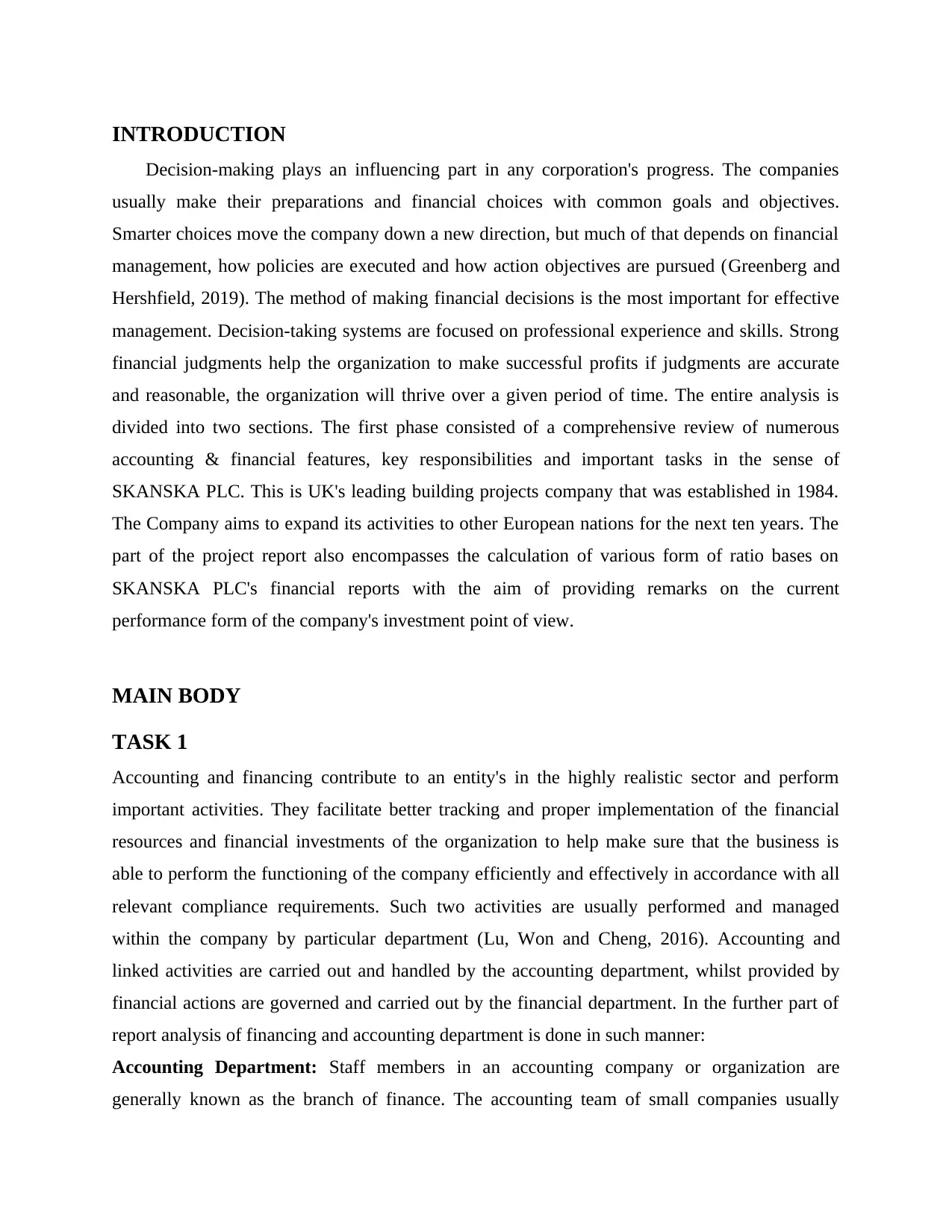
INTRODUCTION
Decision-making plays an influencing part in any corporation's progress. The companies
usually make their preparations and financial choices with common goals and objectives.
Smarter choices move the company down a new direction, but much of that depends on financial
management, how policies are executed and how action objectives are pursued (Greenberg and
Hershfield, 2019). The method of making financial decisions is the most important for effective
management. Decision-taking systems are focused on professional experience and skills. Strong
financial judgments help the organization to make successful profits if judgments are accurate
and reasonable, the organization will thrive over a given period of time. The entire analysis is
divided into two sections. The first phase consisted of a comprehensive review of numerous
accounting & financial features, key responsibilities and important tasks in the sense of
SKANSKA PLC. This is UK's leading building projects company that was established in 1984.
The Company aims to expand its activities to other European nations for the next ten years. The
part of the project report also encompasses the calculation of various form of ratio bases on
SKANSKA PLC's financial reports with the aim of providing remarks on the current
performance form of the company's investment point of view.
MAIN BODY
TASK 1
Accounting and financing contribute to an entity's in the highly realistic sector and perform
important activities. They facilitate better tracking and proper implementation of the financial
resources and financial investments of the organization to help make sure that the business is
able to perform the functioning of the company efficiently and effectively in accordance with all
relevant compliance requirements. Such two activities are usually performed and managed
within the company by particular department (Lu, Won and Cheng, 2016). Accounting and
linked activities are carried out and handled by the accounting department, whilst provided by
financial actions are governed and carried out by the financial department. In the further part of
report analysis of financing and accounting department is done in such manner:
Accounting Department: Staff members in an accounting company or organization are
generally known as the branch of finance. The accounting team of small companies usually
Decision-making plays an influencing part in any corporation's progress. The companies
usually make their preparations and financial choices with common goals and objectives.
Smarter choices move the company down a new direction, but much of that depends on financial
management, how policies are executed and how action objectives are pursued (Greenberg and
Hershfield, 2019). The method of making financial decisions is the most important for effective
management. Decision-taking systems are focused on professional experience and skills. Strong
financial judgments help the organization to make successful profits if judgments are accurate
and reasonable, the organization will thrive over a given period of time. The entire analysis is
divided into two sections. The first phase consisted of a comprehensive review of numerous
accounting & financial features, key responsibilities and important tasks in the sense of
SKANSKA PLC. This is UK's leading building projects company that was established in 1984.
The Company aims to expand its activities to other European nations for the next ten years. The
part of the project report also encompasses the calculation of various form of ratio bases on
SKANSKA PLC's financial reports with the aim of providing remarks on the current
performance form of the company's investment point of view.
MAIN BODY
TASK 1
Accounting and financing contribute to an entity's in the highly realistic sector and perform
important activities. They facilitate better tracking and proper implementation of the financial
resources and financial investments of the organization to help make sure that the business is
able to perform the functioning of the company efficiently and effectively in accordance with all
relevant compliance requirements. Such two activities are usually performed and managed
within the company by particular department (Lu, Won and Cheng, 2016). Accounting and
linked activities are carried out and handled by the accounting department, whilst provided by
financial actions are governed and carried out by the financial department. In the further part of
report analysis of financing and accounting department is done in such manner:
Accounting Department: Staff members in an accounting company or organization are
generally known as the branch of finance. The accounting team of small companies usually
⊘ This is a preview!⊘
Do you want full access?
Subscribe today to unlock all pages.

Trusted by 1+ million students worldwide

consists of 1 or 2 people engaged with accounting matters. Although there can be many
accounting sub-units in larger companies; for example, one unit can tackle taxes, while another
unit may tackle payable, deferred revenue dealing, and so on.
Finance Department: It is an important unit of a company which handles its assets. Finance
department 's corporate duties usually involve preparation, organising, auditing, accounting, and
maintaining the company's financial support. Typically, the financial department also conducted
procedures for drafting and finalizing the financial reports of the organization.
Role and Importance of Accounting and Finance Department:
Accounting department: This department supports the business it refers to with account-related
resources and financial assistance (Loughran and McDonald, 2016). The company must record
receipts and payments reports, product information, payroll sheets, capital investments and all
other sources of funding. Accounting firms shall examine each company's records to determine
the company's financial position and any changes that are necessary for the company's cost-
effective operation. The accountant in Skanska Plc usually includes a committed team of experts
who manage the financing of the business. Though not every member of the team will be a
professional accountant, team leaders will usually be trained under the expertise of accountant.
Through setting up an accounting department, companies may also ensure full transparency of
their financial records and give detailed, organized support to other staff and members.
Finance Department: The significance of the finance department of the corporate entity comes
from its ability to maintain that money is available or sufficient for operational structure and that
the institution can manage the time especially enough to fulfil the liabilities that are exceptional.
Almost all of the crucial importance of the Finance department of the organization lies in its
assignment of combining day-to-day financial choices with longer-term business governance.
Long-term and short-term goals ought to be balanced together with a holistic understanding of
why the enterprise was founded or how the business measures results. Individuals who function
the finance team may not have been top-level employees in Skanska Plc, although they are liable
for providing these senior members with the data and facts that they need to continue providing
leadership qualities.
Functions and Duties of Accounting and Finance department:
accounting sub-units in larger companies; for example, one unit can tackle taxes, while another
unit may tackle payable, deferred revenue dealing, and so on.
Finance Department: It is an important unit of a company which handles its assets. Finance
department 's corporate duties usually involve preparation, organising, auditing, accounting, and
maintaining the company's financial support. Typically, the financial department also conducted
procedures for drafting and finalizing the financial reports of the organization.
Role and Importance of Accounting and Finance Department:
Accounting department: This department supports the business it refers to with account-related
resources and financial assistance (Loughran and McDonald, 2016). The company must record
receipts and payments reports, product information, payroll sheets, capital investments and all
other sources of funding. Accounting firms shall examine each company's records to determine
the company's financial position and any changes that are necessary for the company's cost-
effective operation. The accountant in Skanska Plc usually includes a committed team of experts
who manage the financing of the business. Though not every member of the team will be a
professional accountant, team leaders will usually be trained under the expertise of accountant.
Through setting up an accounting department, companies may also ensure full transparency of
their financial records and give detailed, organized support to other staff and members.
Finance Department: The significance of the finance department of the corporate entity comes
from its ability to maintain that money is available or sufficient for operational structure and that
the institution can manage the time especially enough to fulfil the liabilities that are exceptional.
Almost all of the crucial importance of the Finance department of the organization lies in its
assignment of combining day-to-day financial choices with longer-term business governance.
Long-term and short-term goals ought to be balanced together with a holistic understanding of
why the enterprise was founded or how the business measures results. Individuals who function
the finance team may not have been top-level employees in Skanska Plc, although they are liable
for providing these senior members with the data and facts that they need to continue providing
leadership qualities.
Functions and Duties of Accounting and Finance department:
Paraphrase This Document
Need a fresh take? Get an instant paraphrase of this document with our AI Paraphraser
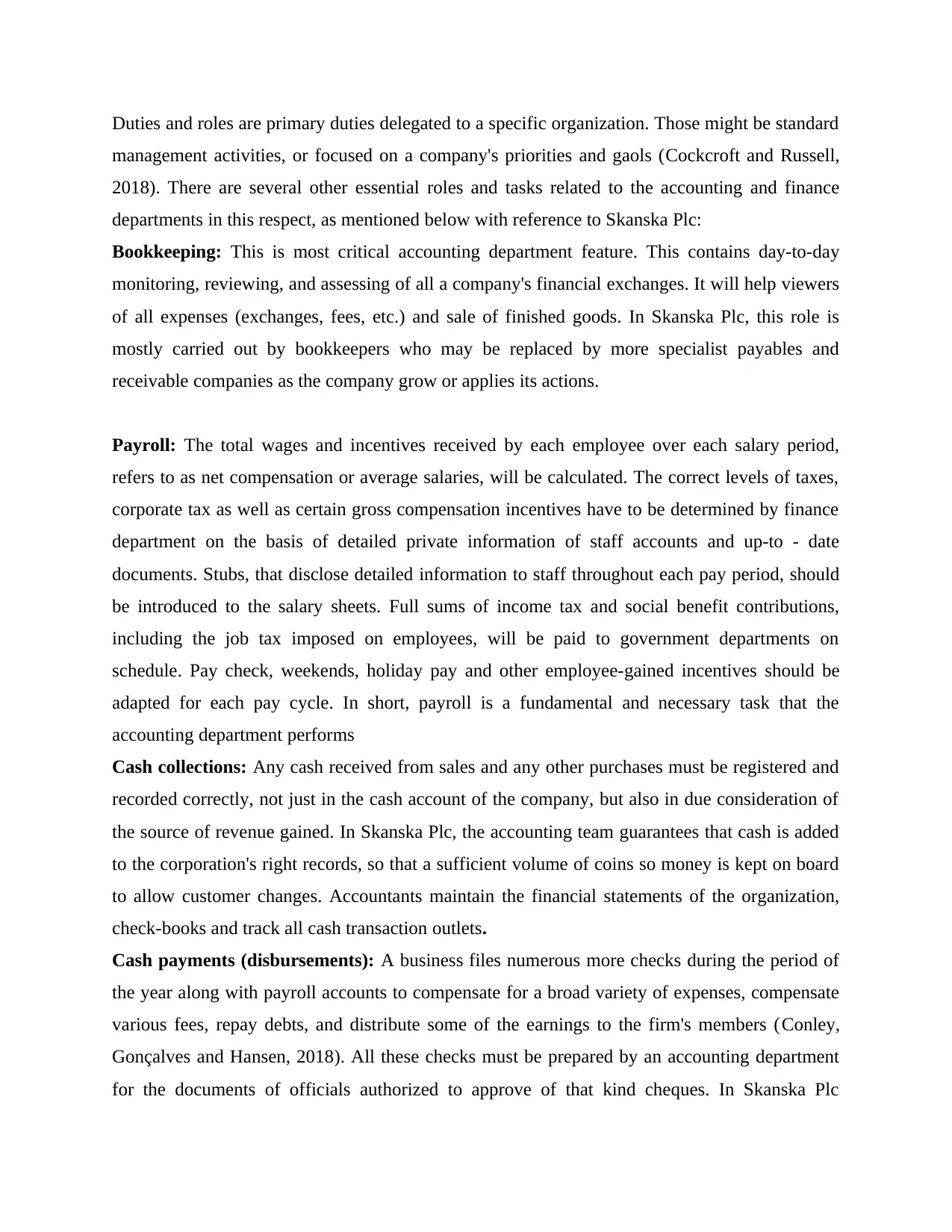
Duties and roles are primary duties delegated to a specific organization. Those might be standard
management activities, or focused on a company's priorities and gaols (Cockcroft and Russell,
2018). There are several other essential roles and tasks related to the accounting and finance
departments in this respect, as mentioned below with reference to Skanska Plc:
Bookkeeping: This is most critical accounting department feature. This contains day-to-day
monitoring, reviewing, and assessing of all a company's financial exchanges. It will help viewers
of all expenses (exchanges, fees, etc.) and sale of finished goods. In Skanska Plc, this role is
mostly carried out by bookkeepers who may be replaced by more specialist payables and
receivable companies as the company grow or applies its actions.
Payroll: The total wages and incentives received by each employee over each salary period,
refers to as net compensation or average salaries, will be calculated. The correct levels of taxes,
corporate tax as well as certain gross compensation incentives have to be determined by finance
department on the basis of detailed private information of staff accounts and up-to - date
documents. Stubs, that disclose detailed information to staff throughout each pay period, should
be introduced to the salary sheets. Full sums of income tax and social benefit contributions,
including the job tax imposed on employees, will be paid to government departments on
schedule. Pay check, weekends, holiday pay and other employee-gained incentives should be
adapted for each pay cycle. In short, payroll is a fundamental and necessary task that the
accounting department performs
Cash collections: Any cash received from sales and any other purchases must be registered and
recorded correctly, not just in the cash account of the company, but also in due consideration of
the source of revenue gained. In Skanska Plc, the accounting team guarantees that cash is added
to the corporation's right records, so that a sufficient volume of coins so money is kept on board
to allow customer changes. Accountants maintain the financial statements of the organization,
check-books and track all cash transaction outlets.
Cash payments (disbursements): A business files numerous more checks during the period of
the year along with payroll accounts to compensate for a broad variety of expenses, compensate
various fees, repay debts, and distribute some of the earnings to the firm's members (Conley,
Gonçalves and Hansen, 2018). All these checks must be prepared by an accounting department
for the documents of officials authorized to approve of that kind cheques. In Skanska Plc
management activities, or focused on a company's priorities and gaols (Cockcroft and Russell,
2018). There are several other essential roles and tasks related to the accounting and finance
departments in this respect, as mentioned below with reference to Skanska Plc:
Bookkeeping: This is most critical accounting department feature. This contains day-to-day
monitoring, reviewing, and assessing of all a company's financial exchanges. It will help viewers
of all expenses (exchanges, fees, etc.) and sale of finished goods. In Skanska Plc, this role is
mostly carried out by bookkeepers who may be replaced by more specialist payables and
receivable companies as the company grow or applies its actions.
Payroll: The total wages and incentives received by each employee over each salary period,
refers to as net compensation or average salaries, will be calculated. The correct levels of taxes,
corporate tax as well as certain gross compensation incentives have to be determined by finance
department on the basis of detailed private information of staff accounts and up-to - date
documents. Stubs, that disclose detailed information to staff throughout each pay period, should
be introduced to the salary sheets. Full sums of income tax and social benefit contributions,
including the job tax imposed on employees, will be paid to government departments on
schedule. Pay check, weekends, holiday pay and other employee-gained incentives should be
adapted for each pay cycle. In short, payroll is a fundamental and necessary task that the
accounting department performs
Cash collections: Any cash received from sales and any other purchases must be registered and
recorded correctly, not just in the cash account of the company, but also in due consideration of
the source of revenue gained. In Skanska Plc, the accounting team guarantees that cash is added
to the corporation's right records, so that a sufficient volume of coins so money is kept on board
to allow customer changes. Accountants maintain the financial statements of the organization,
check-books and track all cash transaction outlets.
Cash payments (disbursements): A business files numerous more checks during the period of
the year along with payroll accounts to compensate for a broad variety of expenses, compensate
various fees, repay debts, and distribute some of the earnings to the firm's members (Conley,
Gonçalves and Hansen, 2018). All these checks must be prepared by an accounting department
for the documents of officials authorized to approve of that kind cheques. In Skanska Plc
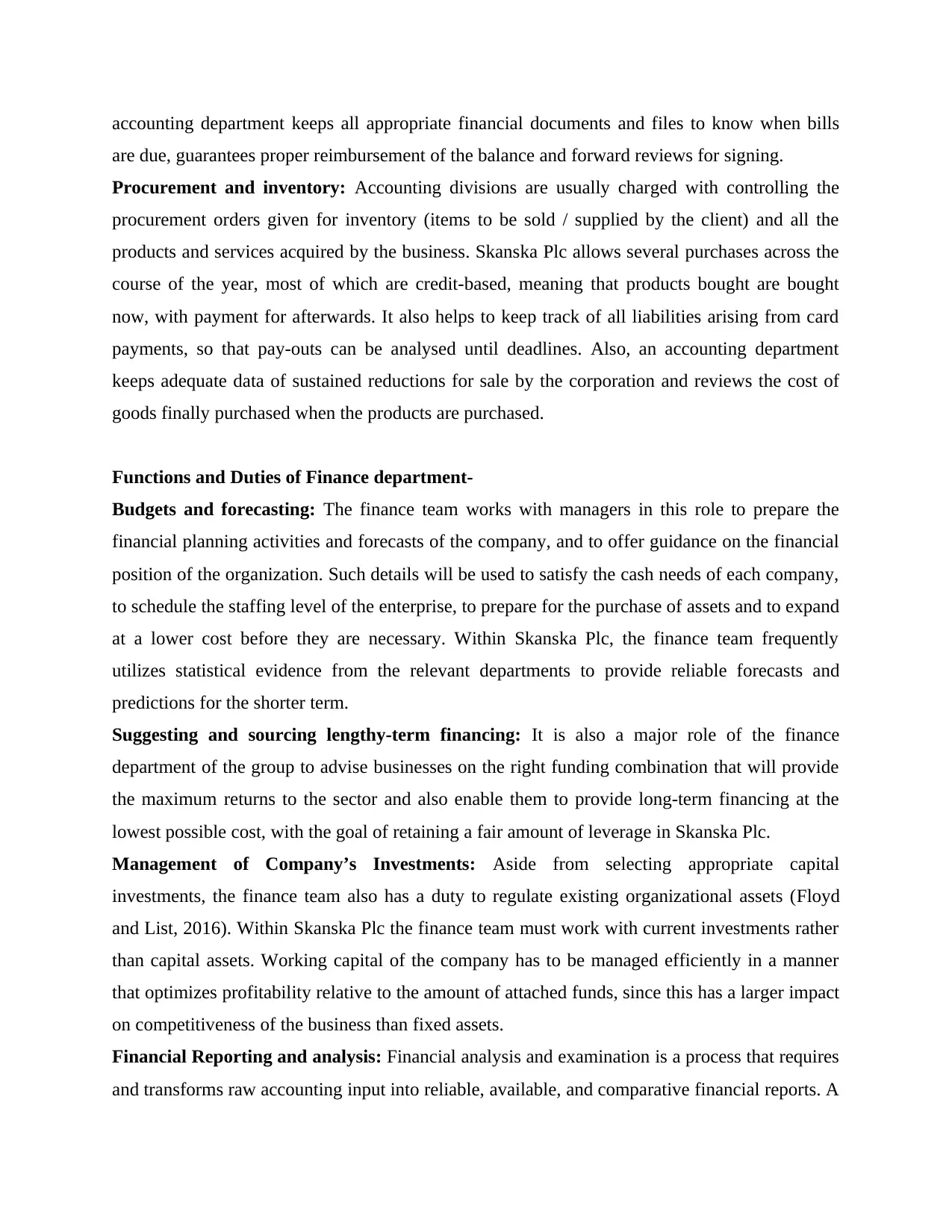
accounting department keeps all appropriate financial documents and files to know when bills
are due, guarantees proper reimbursement of the balance and forward reviews for signing.
Procurement and inventory: Accounting divisions are usually charged with controlling the
procurement orders given for inventory (items to be sold / supplied by the client) and all the
products and services acquired by the business. Skanska Plc allows several purchases across the
course of the year, most of which are credit-based, meaning that products bought are bought
now, with payment for afterwards. It also helps to keep track of all liabilities arising from card
payments, so that pay-outs can be analysed until deadlines. Also, an accounting department
keeps adequate data of sustained reductions for sale by the corporation and reviews the cost of
goods finally purchased when the products are purchased.
Functions and Duties of Finance department-
Budgets and forecasting: The finance team works with managers in this role to prepare the
financial planning activities and forecasts of the company, and to offer guidance on the financial
position of the organization. Such details will be used to satisfy the cash needs of each company,
to schedule the staffing level of the enterprise, to prepare for the purchase of assets and to expand
at a lower cost before they are necessary. Within Skanska Plc, the finance team frequently
utilizes statistical evidence from the relevant departments to provide reliable forecasts and
predictions for the shorter term.
Suggesting and sourcing lengthy-term financing: It is also a major role of the finance
department of the group to advise businesses on the right funding combination that will provide
the maximum returns to the sector and also enable them to provide long-term financing at the
lowest possible cost, with the goal of retaining a fair amount of leverage in Skanska Plc.
Management of Company’s Investments: Aside from selecting appropriate capital
investments, the finance team also has a duty to regulate existing organizational assets (Floyd
and List, 2016). Within Skanska Plc the finance team must work with current investments rather
than capital assets. Working capital of the company has to be managed efficiently in a manner
that optimizes profitability relative to the amount of attached funds, since this has a larger impact
on competitiveness of the business than fixed assets.
Financial Reporting and analysis: Financial analysis and examination is a process that requires
and transforms raw accounting input into reliable, available, and comparative financial reports. A
are due, guarantees proper reimbursement of the balance and forward reviews for signing.
Procurement and inventory: Accounting divisions are usually charged with controlling the
procurement orders given for inventory (items to be sold / supplied by the client) and all the
products and services acquired by the business. Skanska Plc allows several purchases across the
course of the year, most of which are credit-based, meaning that products bought are bought
now, with payment for afterwards. It also helps to keep track of all liabilities arising from card
payments, so that pay-outs can be analysed until deadlines. Also, an accounting department
keeps adequate data of sustained reductions for sale by the corporation and reviews the cost of
goods finally purchased when the products are purchased.
Functions and Duties of Finance department-
Budgets and forecasting: The finance team works with managers in this role to prepare the
financial planning activities and forecasts of the company, and to offer guidance on the financial
position of the organization. Such details will be used to satisfy the cash needs of each company,
to schedule the staffing level of the enterprise, to prepare for the purchase of assets and to expand
at a lower cost before they are necessary. Within Skanska Plc, the finance team frequently
utilizes statistical evidence from the relevant departments to provide reliable forecasts and
predictions for the shorter term.
Suggesting and sourcing lengthy-term financing: It is also a major role of the finance
department of the group to advise businesses on the right funding combination that will provide
the maximum returns to the sector and also enable them to provide long-term financing at the
lowest possible cost, with the goal of retaining a fair amount of leverage in Skanska Plc.
Management of Company’s Investments: Aside from selecting appropriate capital
investments, the finance team also has a duty to regulate existing organizational assets (Floyd
and List, 2016). Within Skanska Plc the finance team must work with current investments rather
than capital assets. Working capital of the company has to be managed efficiently in a manner
that optimizes profitability relative to the amount of attached funds, since this has a larger impact
on competitiveness of the business than fixed assets.
Financial Reporting and analysis: Financial analysis and examination is a process that requires
and transforms raw accounting input into reliable, available, and comparative financial reports. A
⊘ This is a preview!⊘
Do you want full access?
Subscribe today to unlock all pages.

Trusted by 1+ million students worldwide
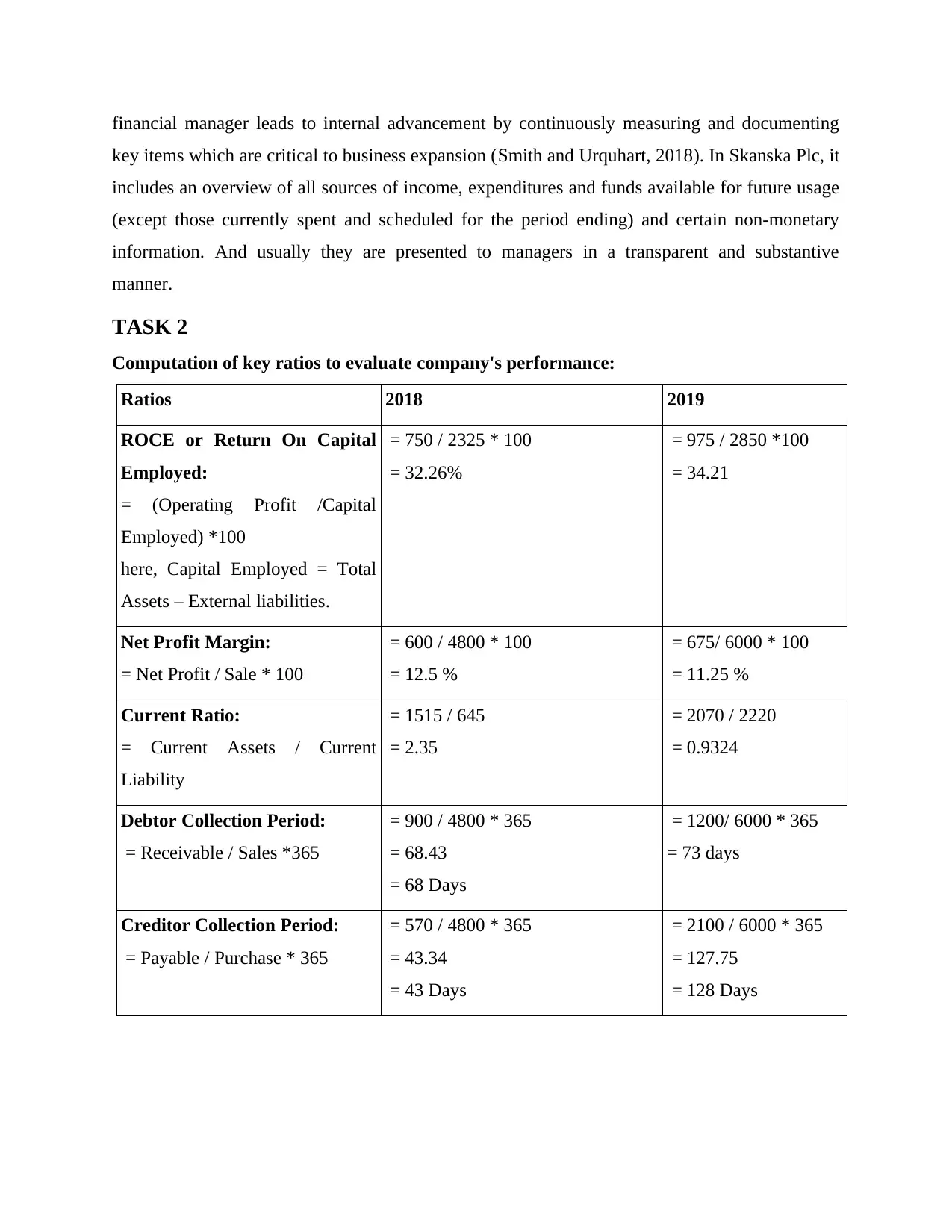
financial manager leads to internal advancement by continuously measuring and documenting
key items which are critical to business expansion (Smith and Urquhart, 2018). In Skanska Plc, it
includes an overview of all sources of income, expenditures and funds available for future usage
(except those currently spent and scheduled for the period ending) and certain non-monetary
information. And usually they are presented to managers in a transparent and substantive
manner.
TASK 2
Computation of key ratios to evaluate company's performance:
Ratios 2018 2019
ROCE or Return On Capital
Employed:
= (Operating Profit /Capital
Employed) *100
here, Capital Employed = Total
Assets – External liabilities.
= 750 / 2325 * 100
= 32.26%
= 975 / 2850 *100
= 34.21
Net Profit Margin:
= Net Profit / Sale * 100
= 600 / 4800 * 100
= 12.5 %
= 675/ 6000 * 100
= 11.25 %
Current Ratio:
= Current Assets / Current
Liability
= 1515 / 645
= 2.35
= 2070 / 2220
= 0.9324
Debtor Collection Period:
= Receivable / Sales *365
= 900 / 4800 * 365
= 68.43
= 68 Days
= 1200/ 6000 * 365
= 73 days
Creditor Collection Period:
= Payable / Purchase * 365
= 570 / 4800 * 365
= 43.34
= 43 Days
= 2100 / 6000 * 365
= 127.75
= 128 Days
key items which are critical to business expansion (Smith and Urquhart, 2018). In Skanska Plc, it
includes an overview of all sources of income, expenditures and funds available for future usage
(except those currently spent and scheduled for the period ending) and certain non-monetary
information. And usually they are presented to managers in a transparent and substantive
manner.
TASK 2
Computation of key ratios to evaluate company's performance:
Ratios 2018 2019
ROCE or Return On Capital
Employed:
= (Operating Profit /Capital
Employed) *100
here, Capital Employed = Total
Assets – External liabilities.
= 750 / 2325 * 100
= 32.26%
= 975 / 2850 *100
= 34.21
Net Profit Margin:
= Net Profit / Sale * 100
= 600 / 4800 * 100
= 12.5 %
= 675/ 6000 * 100
= 11.25 %
Current Ratio:
= Current Assets / Current
Liability
= 1515 / 645
= 2.35
= 2070 / 2220
= 0.9324
Debtor Collection Period:
= Receivable / Sales *365
= 900 / 4800 * 365
= 68.43
= 68 Days
= 1200/ 6000 * 365
= 73 days
Creditor Collection Period:
= Payable / Purchase * 365
= 570 / 4800 * 365
= 43.34
= 43 Days
= 2100 / 6000 * 365
= 127.75
= 128 Days
Paraphrase This Document
Need a fresh take? Get an instant paraphrase of this document with our AI Paraphraser
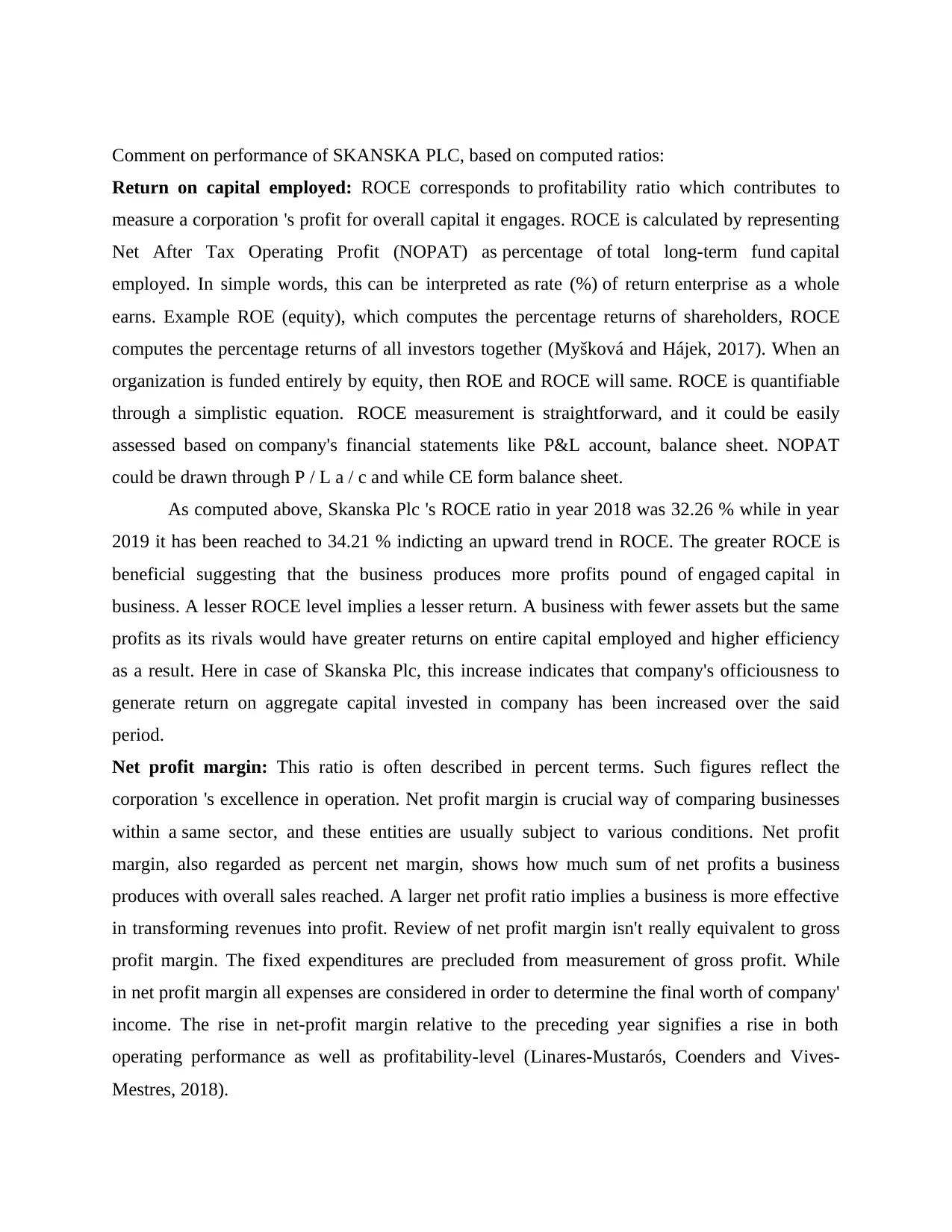
Comment on performance of SKANSKA PLC, based on computed ratios:
Return on capital employed: ROCE corresponds to profitability ratio which contributes to
measure a corporation 's profit for overall capital it engages. ROCE is calculated by representing
Net After Tax Operating Profit (NOPAT) as percentage of total long-term fund capital
employed. In simple words, this can be interpreted as rate (%) of return enterprise as a whole
earns. Example ROE (equity), which computes the percentage returns of shareholders, ROCE
computes the percentage returns of all investors together (Myšková and Hájek, 2017). When an
organization is funded entirely by equity, then ROE and ROCE will same. ROCE is quantifiable
through a simplistic equation. ROCE measurement is straightforward, and it could be easily
assessed based on company's financial statements like P&L account, balance sheet. NOPAT
could be drawn through P / L a / c and while CE form balance sheet.
As computed above, Skanska Plc 's ROCE ratio in year 2018 was 32.26 % while in year
2019 it has been reached to 34.21 % indicting an upward trend in ROCE. The greater ROCE is
beneficial suggesting that the business produces more profits pound of engaged capital in
business. A lesser ROCE level implies a lesser return. A business with fewer assets but the same
profits as its rivals would have greater returns on entire capital employed and higher efficiency
as a result. Here in case of Skanska Plc, this increase indicates that company's officiousness to
generate return on aggregate capital invested in company has been increased over the said
period.
Net profit margin: This ratio is often described in percent terms. Such figures reflect the
corporation 's excellence in operation. Net profit margin is crucial way of comparing businesses
within a same sector, and these entities are usually subject to various conditions. Net profit
margin, also regarded as percent net margin, shows how much sum of net profits a business
produces with overall sales reached. A larger net profit ratio implies a business is more effective
in transforming revenues into profit. Review of net profit margin isn't really equivalent to gross
profit margin. The fixed expenditures are precluded from measurement of gross profit. While
in net profit margin all expenses are considered in order to determine the final worth of company'
income. The rise in net-profit margin relative to the preceding year signifies a rise in both
operating performance as well as profitability-level (Linares-Mustarós, Coenders and Vives-
Mestres, 2018).
Return on capital employed: ROCE corresponds to profitability ratio which contributes to
measure a corporation 's profit for overall capital it engages. ROCE is calculated by representing
Net After Tax Operating Profit (NOPAT) as percentage of total long-term fund capital
employed. In simple words, this can be interpreted as rate (%) of return enterprise as a whole
earns. Example ROE (equity), which computes the percentage returns of shareholders, ROCE
computes the percentage returns of all investors together (Myšková and Hájek, 2017). When an
organization is funded entirely by equity, then ROE and ROCE will same. ROCE is quantifiable
through a simplistic equation. ROCE measurement is straightforward, and it could be easily
assessed based on company's financial statements like P&L account, balance sheet. NOPAT
could be drawn through P / L a / c and while CE form balance sheet.
As computed above, Skanska Plc 's ROCE ratio in year 2018 was 32.26 % while in year
2019 it has been reached to 34.21 % indicting an upward trend in ROCE. The greater ROCE is
beneficial suggesting that the business produces more profits pound of engaged capital in
business. A lesser ROCE level implies a lesser return. A business with fewer assets but the same
profits as its rivals would have greater returns on entire capital employed and higher efficiency
as a result. Here in case of Skanska Plc, this increase indicates that company's officiousness to
generate return on aggregate capital invested in company has been increased over the said
period.
Net profit margin: This ratio is often described in percent terms. Such figures reflect the
corporation 's excellence in operation. Net profit margin is crucial way of comparing businesses
within a same sector, and these entities are usually subject to various conditions. Net profit
margin, also regarded as percent net margin, shows how much sum of net profits a business
produces with overall sales reached. A larger net profit ratio implies a business is more effective
in transforming revenues into profit. Review of net profit margin isn't really equivalent to gross
profit margin. The fixed expenditures are precluded from measurement of gross profit. While
in net profit margin all expenses are considered in order to determine the final worth of company'
income. The rise in net-profit margin relative to the preceding year signifies a rise in both
operating performance as well as profitability-level (Linares-Mustarós, Coenders and Vives-
Mestres, 2018).
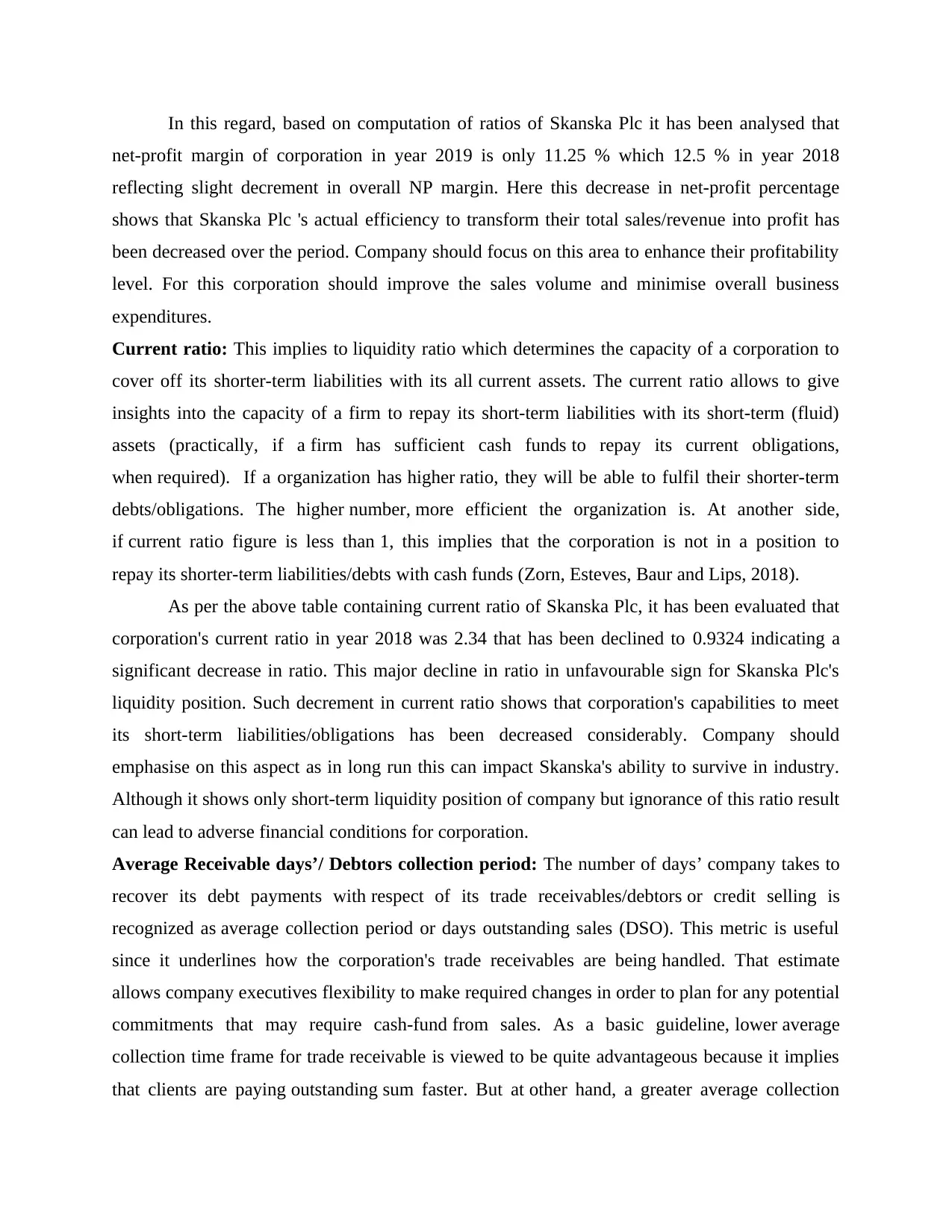
In this regard, based on computation of ratios of Skanska Plc it has been analysed that
net-profit margin of corporation in year 2019 is only 11.25 % which 12.5 % in year 2018
reflecting slight decrement in overall NP margin. Here this decrease in net-profit percentage
shows that Skanska Plc 's actual efficiency to transform their total sales/revenue into profit has
been decreased over the period. Company should focus on this area to enhance their profitability
level. For this corporation should improve the sales volume and minimise overall business
expenditures.
Current ratio: This implies to liquidity ratio which determines the capacity of a corporation to
cover off its shorter-term liabilities with its all current assets. The current ratio allows to give
insights into the capacity of a firm to repay its short-term liabilities with its short-term (fluid)
assets (practically, if a firm has sufficient cash funds to repay its current obligations,
when required). If a organization has higher ratio, they will be able to fulfil their shorter-term
debts/obligations. The higher number, more efficient the organization is. At another side,
if current ratio figure is less than 1, this implies that the corporation is not in a position to
repay its shorter-term liabilities/debts with cash funds (Zorn, Esteves, Baur and Lips, 2018).
As per the above table containing current ratio of Skanska Plc, it has been evaluated that
corporation's current ratio in year 2018 was 2.34 that has been declined to 0.9324 indicating a
significant decrease in ratio. This major decline in ratio in unfavourable sign for Skanska Plc's
liquidity position. Such decrement in current ratio shows that corporation's capabilities to meet
its short-term liabilities/obligations has been decreased considerably. Company should
emphasise on this aspect as in long run this can impact Skanska's ability to survive in industry.
Although it shows only short-term liquidity position of company but ignorance of this ratio result
can lead to adverse financial conditions for corporation.
Average Receivable days’/ Debtors collection period: The number of days’ company takes to
recover its debt payments with respect of its trade receivables/debtors or credit selling is
recognized as average collection period or days outstanding sales (DSO). This metric is useful
since it underlines how the corporation's trade receivables are being handled. That estimate
allows company executives flexibility to make required changes in order to plan for any potential
commitments that may require cash-fund from sales. As a basic guideline, lower average
collection time frame for trade receivable is viewed to be quite advantageous because it implies
that clients are paying outstanding sum faster. But at other hand, a greater average collection
net-profit margin of corporation in year 2019 is only 11.25 % which 12.5 % in year 2018
reflecting slight decrement in overall NP margin. Here this decrease in net-profit percentage
shows that Skanska Plc 's actual efficiency to transform their total sales/revenue into profit has
been decreased over the period. Company should focus on this area to enhance their profitability
level. For this corporation should improve the sales volume and minimise overall business
expenditures.
Current ratio: This implies to liquidity ratio which determines the capacity of a corporation to
cover off its shorter-term liabilities with its all current assets. The current ratio allows to give
insights into the capacity of a firm to repay its short-term liabilities with its short-term (fluid)
assets (practically, if a firm has sufficient cash funds to repay its current obligations,
when required). If a organization has higher ratio, they will be able to fulfil their shorter-term
debts/obligations. The higher number, more efficient the organization is. At another side,
if current ratio figure is less than 1, this implies that the corporation is not in a position to
repay its shorter-term liabilities/debts with cash funds (Zorn, Esteves, Baur and Lips, 2018).
As per the above table containing current ratio of Skanska Plc, it has been evaluated that
corporation's current ratio in year 2018 was 2.34 that has been declined to 0.9324 indicating a
significant decrease in ratio. This major decline in ratio in unfavourable sign for Skanska Plc's
liquidity position. Such decrement in current ratio shows that corporation's capabilities to meet
its short-term liabilities/obligations has been decreased considerably. Company should
emphasise on this aspect as in long run this can impact Skanska's ability to survive in industry.
Although it shows only short-term liquidity position of company but ignorance of this ratio result
can lead to adverse financial conditions for corporation.
Average Receivable days’/ Debtors collection period: The number of days’ company takes to
recover its debt payments with respect of its trade receivables/debtors or credit selling is
recognized as average collection period or days outstanding sales (DSO). This metric is useful
since it underlines how the corporation's trade receivables are being handled. That estimate
allows company executives flexibility to make required changes in order to plan for any potential
commitments that may require cash-fund from sales. As a basic guideline, lower average
collection time frame for trade receivable is viewed to be quite advantageous because it implies
that clients are paying outstanding sum faster. But at other hand, a greater average collection
⊘ This is a preview!⊘
Do you want full access?
Subscribe today to unlock all pages.

Trusted by 1+ million students worldwide
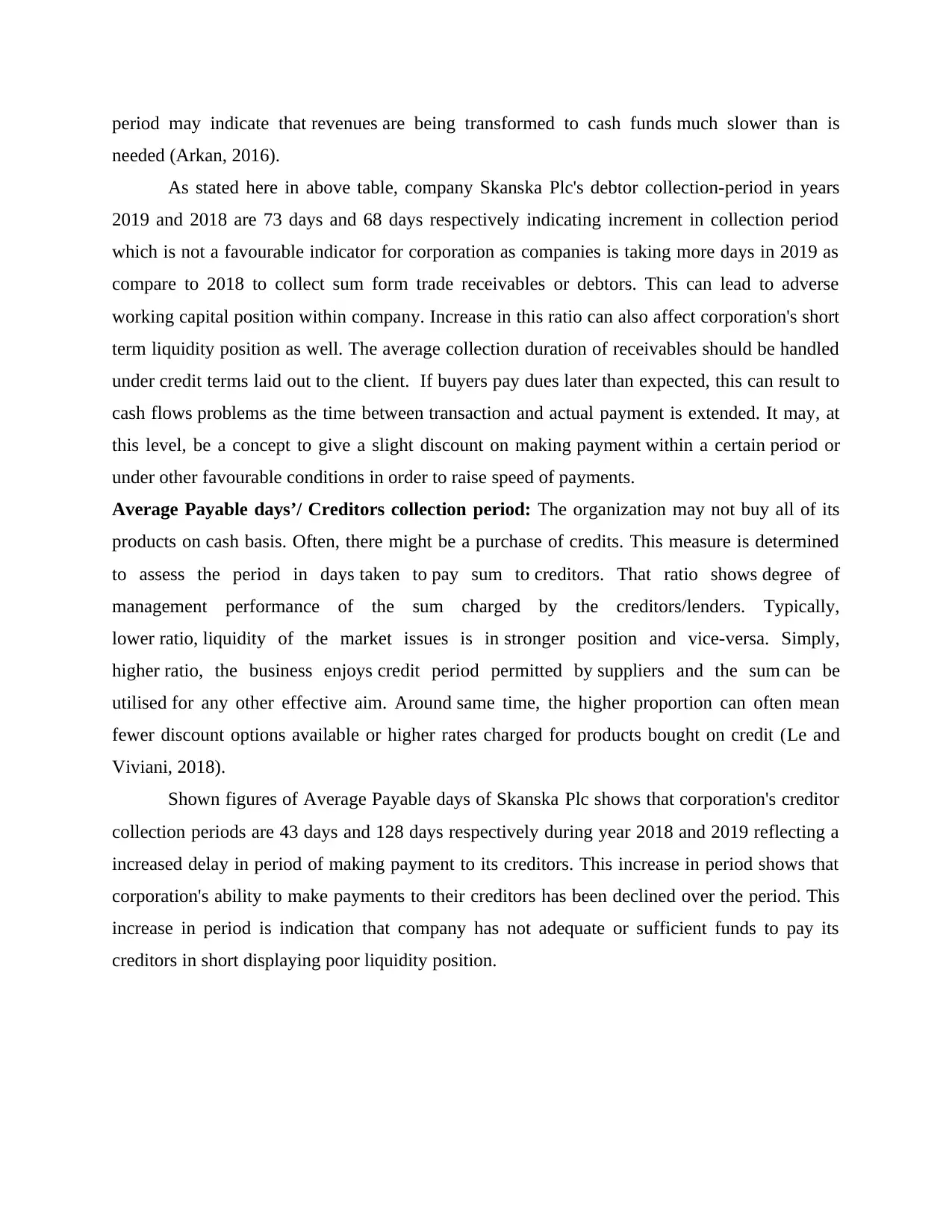
period may indicate that revenues are being transformed to cash funds much slower than is
needed (Arkan, 2016).
As stated here in above table, company Skanska Plc's debtor collection-period in years
2019 and 2018 are 73 days and 68 days respectively indicating increment in collection period
which is not a favourable indicator for corporation as companies is taking more days in 2019 as
compare to 2018 to collect sum form trade receivables or debtors. This can lead to adverse
working capital position within company. Increase in this ratio can also affect corporation's short
term liquidity position as well. The average collection duration of receivables should be handled
under credit terms laid out to the client. If buyers pay dues later than expected, this can result to
cash flows problems as the time between transaction and actual payment is extended. It may, at
this level, be a concept to give a slight discount on making payment within a certain period or
under other favourable conditions in order to raise speed of payments.
Average Payable days’/ Creditors collection period: The organization may not buy all of its
products on cash basis. Often, there might be a purchase of credits. This measure is determined
to assess the period in days taken to pay sum to creditors. That ratio shows degree of
management performance of the sum charged by the creditors/lenders. Typically,
lower ratio, liquidity of the market issues is in stronger position and vice-versa. Simply,
higher ratio, the business enjoys credit period permitted by suppliers and the sum can be
utilised for any other effective aim. Around same time, the higher proportion can often mean
fewer discount options available or higher rates charged for products bought on credit (Le and
Viviani, 2018).
Shown figures of Average Payable days of Skanska Plc shows that corporation's creditor
collection periods are 43 days and 128 days respectively during year 2018 and 2019 reflecting a
increased delay in period of making payment to its creditors. This increase in period shows that
corporation's ability to make payments to their creditors has been declined over the period. This
increase in period is indication that company has not adequate or sufficient funds to pay its
creditors in short displaying poor liquidity position.
needed (Arkan, 2016).
As stated here in above table, company Skanska Plc's debtor collection-period in years
2019 and 2018 are 73 days and 68 days respectively indicating increment in collection period
which is not a favourable indicator for corporation as companies is taking more days in 2019 as
compare to 2018 to collect sum form trade receivables or debtors. This can lead to adverse
working capital position within company. Increase in this ratio can also affect corporation's short
term liquidity position as well. The average collection duration of receivables should be handled
under credit terms laid out to the client. If buyers pay dues later than expected, this can result to
cash flows problems as the time between transaction and actual payment is extended. It may, at
this level, be a concept to give a slight discount on making payment within a certain period or
under other favourable conditions in order to raise speed of payments.
Average Payable days’/ Creditors collection period: The organization may not buy all of its
products on cash basis. Often, there might be a purchase of credits. This measure is determined
to assess the period in days taken to pay sum to creditors. That ratio shows degree of
management performance of the sum charged by the creditors/lenders. Typically,
lower ratio, liquidity of the market issues is in stronger position and vice-versa. Simply,
higher ratio, the business enjoys credit period permitted by suppliers and the sum can be
utilised for any other effective aim. Around same time, the higher proportion can often mean
fewer discount options available or higher rates charged for products bought on credit (Le and
Viviani, 2018).
Shown figures of Average Payable days of Skanska Plc shows that corporation's creditor
collection periods are 43 days and 128 days respectively during year 2018 and 2019 reflecting a
increased delay in period of making payment to its creditors. This increase in period shows that
corporation's ability to make payments to their creditors has been declined over the period. This
increase in period is indication that company has not adequate or sufficient funds to pay its
creditors in short displaying poor liquidity position.
Paraphrase This Document
Need a fresh take? Get an instant paraphrase of this document with our AI Paraphraser
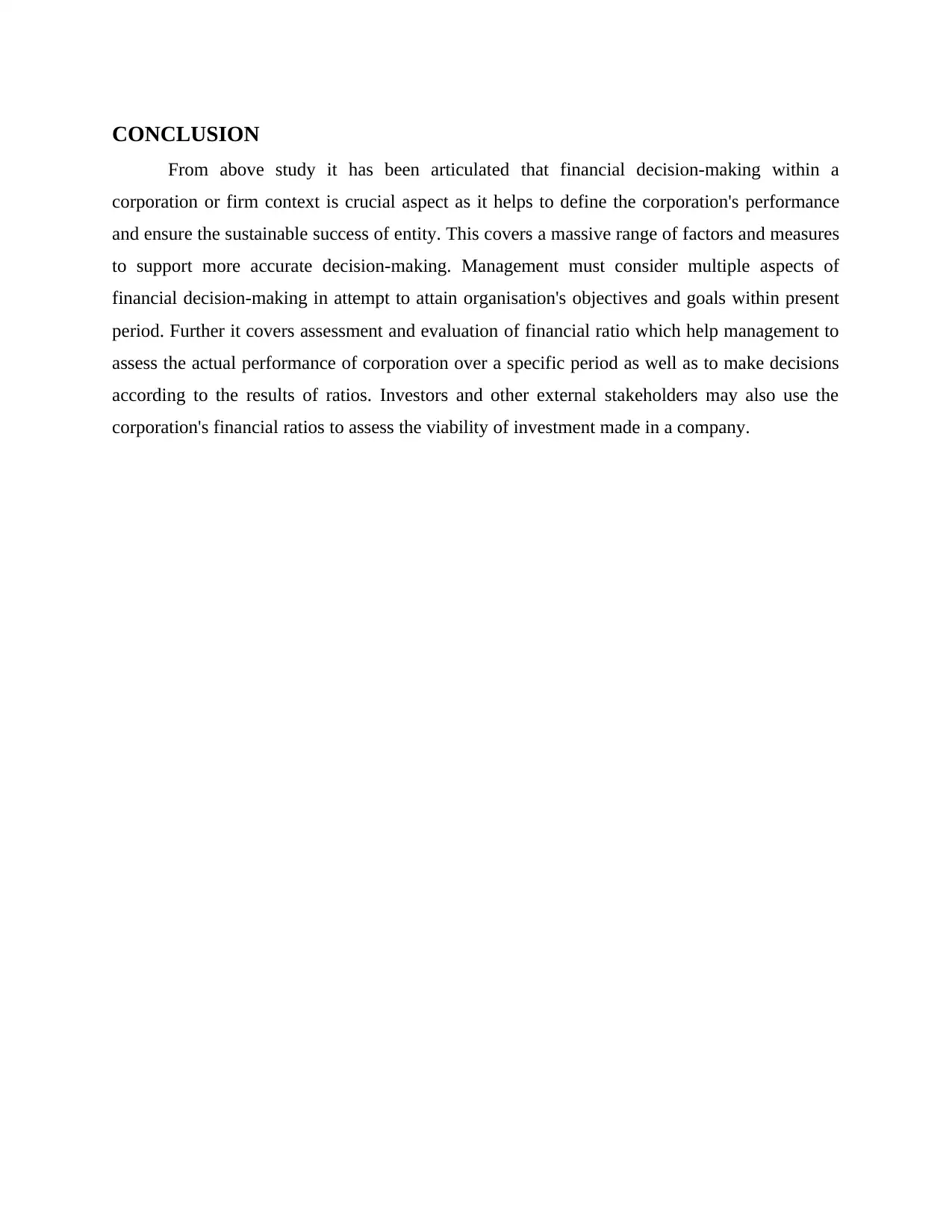
CONCLUSION
From above study it has been articulated that financial decision-making within a
corporation or firm context is crucial aspect as it helps to define the corporation's performance
and ensure the sustainable success of entity. This covers a massive range of factors and measures
to support more accurate decision-making. Management must consider multiple aspects of
financial decision-making in attempt to attain organisation's objectives and goals within present
period. Further it covers assessment and evaluation of financial ratio which help management to
assess the actual performance of corporation over a specific period as well as to make decisions
according to the results of ratios. Investors and other external stakeholders may also use the
corporation's financial ratios to assess the viability of investment made in a company.
From above study it has been articulated that financial decision-making within a
corporation or firm context is crucial aspect as it helps to define the corporation's performance
and ensure the sustainable success of entity. This covers a massive range of factors and measures
to support more accurate decision-making. Management must consider multiple aspects of
financial decision-making in attempt to attain organisation's objectives and goals within present
period. Further it covers assessment and evaluation of financial ratio which help management to
assess the actual performance of corporation over a specific period as well as to make decisions
according to the results of ratios. Investors and other external stakeholders may also use the
corporation's financial ratios to assess the viability of investment made in a company.
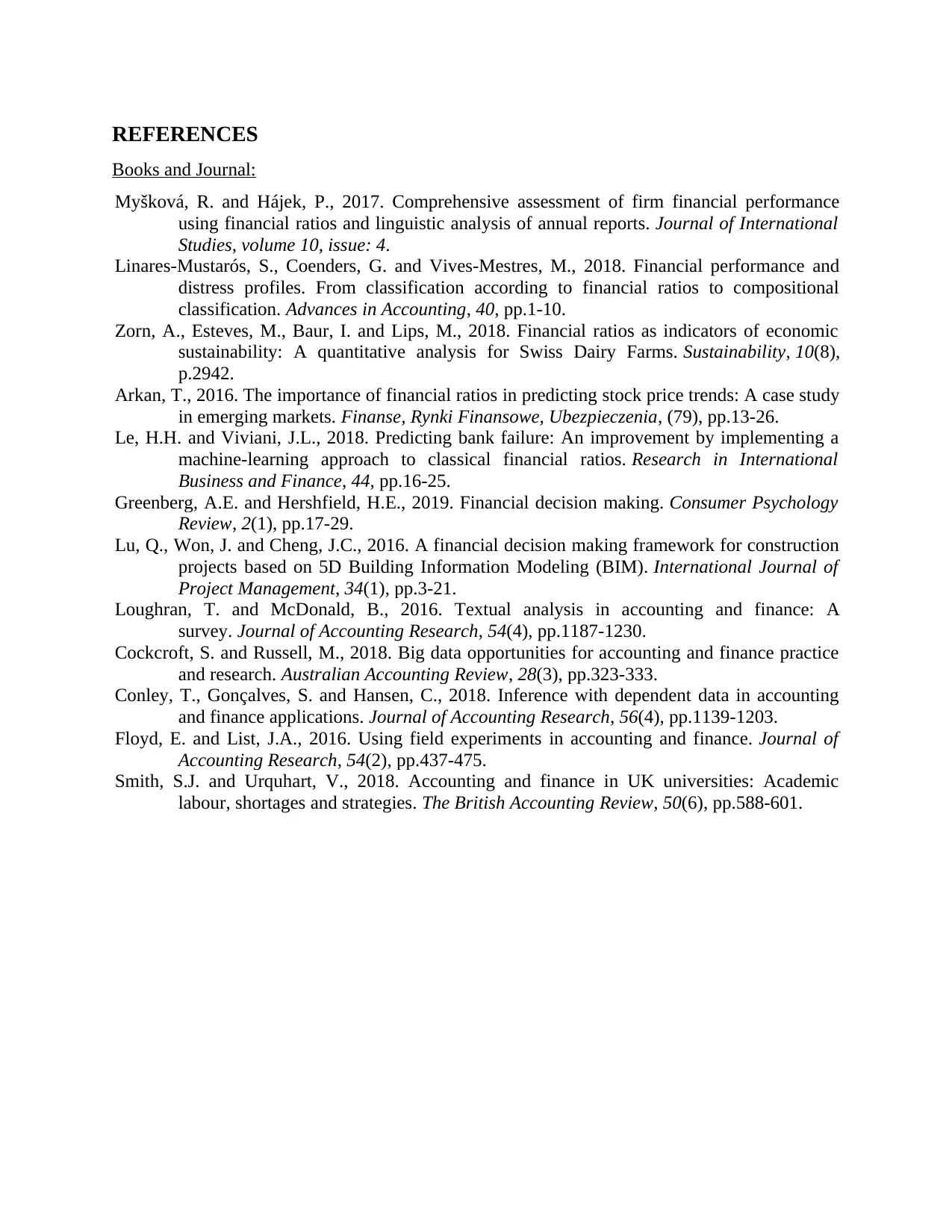
REFERENCES
Books and Journal:
Myšková, R. and Hájek, P., 2017. Comprehensive assessment of firm financial performance
using financial ratios and linguistic analysis of annual reports. Journal of International
Studies, volume 10, issue: 4.
Linares-Mustarós, S., Coenders, G. and Vives-Mestres, M., 2018. Financial performance and
distress profiles. From classification according to financial ratios to compositional
classification. Advances in Accounting, 40, pp.1-10.
Zorn, A., Esteves, M., Baur, I. and Lips, M., 2018. Financial ratios as indicators of economic
sustainability: A quantitative analysis for Swiss Dairy Farms. Sustainability, 10(8),
p.2942.
Arkan, T., 2016. The importance of financial ratios in predicting stock price trends: A case study
in emerging markets. Finanse, Rynki Finansowe, Ubezpieczenia, (79), pp.13-26.
Le, H.H. and Viviani, J.L., 2018. Predicting bank failure: An improvement by implementing a
machine-learning approach to classical financial ratios. Research in International
Business and Finance, 44, pp.16-25.
Greenberg, A.E. and Hershfield, H.E., 2019. Financial decision making. Consumer Psychology
Review, 2(1), pp.17-29.
Lu, Q., Won, J. and Cheng, J.C., 2016. A financial decision making framework for construction
projects based on 5D Building Information Modeling (BIM). International Journal of
Project Management, 34(1), pp.3-21.
Loughran, T. and McDonald, B., 2016. Textual analysis in accounting and finance: A
survey. Journal of Accounting Research, 54(4), pp.1187-1230.
Cockcroft, S. and Russell, M., 2018. Big data opportunities for accounting and finance practice
and research. Australian Accounting Review, 28(3), pp.323-333.
Conley, T., Gonçalves, S. and Hansen, C., 2018. Inference with dependent data in accounting
and finance applications. Journal of Accounting Research, 56(4), pp.1139-1203.
Floyd, E. and List, J.A., 2016. Using field experiments in accounting and finance. Journal of
Accounting Research, 54(2), pp.437-475.
Smith, S.J. and Urquhart, V., 2018. Accounting and finance in UK universities: Academic
labour, shortages and strategies. The British Accounting Review, 50(6), pp.588-601.
Books and Journal:
Myšková, R. and Hájek, P., 2017. Comprehensive assessment of firm financial performance
using financial ratios and linguistic analysis of annual reports. Journal of International
Studies, volume 10, issue: 4.
Linares-Mustarós, S., Coenders, G. and Vives-Mestres, M., 2018. Financial performance and
distress profiles. From classification according to financial ratios to compositional
classification. Advances in Accounting, 40, pp.1-10.
Zorn, A., Esteves, M., Baur, I. and Lips, M., 2018. Financial ratios as indicators of economic
sustainability: A quantitative analysis for Swiss Dairy Farms. Sustainability, 10(8),
p.2942.
Arkan, T., 2016. The importance of financial ratios in predicting stock price trends: A case study
in emerging markets. Finanse, Rynki Finansowe, Ubezpieczenia, (79), pp.13-26.
Le, H.H. and Viviani, J.L., 2018. Predicting bank failure: An improvement by implementing a
machine-learning approach to classical financial ratios. Research in International
Business and Finance, 44, pp.16-25.
Greenberg, A.E. and Hershfield, H.E., 2019. Financial decision making. Consumer Psychology
Review, 2(1), pp.17-29.
Lu, Q., Won, J. and Cheng, J.C., 2016. A financial decision making framework for construction
projects based on 5D Building Information Modeling (BIM). International Journal of
Project Management, 34(1), pp.3-21.
Loughran, T. and McDonald, B., 2016. Textual analysis in accounting and finance: A
survey. Journal of Accounting Research, 54(4), pp.1187-1230.
Cockcroft, S. and Russell, M., 2018. Big data opportunities for accounting and finance practice
and research. Australian Accounting Review, 28(3), pp.323-333.
Conley, T., Gonçalves, S. and Hansen, C., 2018. Inference with dependent data in accounting
and finance applications. Journal of Accounting Research, 56(4), pp.1139-1203.
Floyd, E. and List, J.A., 2016. Using field experiments in accounting and finance. Journal of
Accounting Research, 54(2), pp.437-475.
Smith, S.J. and Urquhart, V., 2018. Accounting and finance in UK universities: Academic
labour, shortages and strategies. The British Accounting Review, 50(6), pp.588-601.
⊘ This is a preview!⊘
Do you want full access?
Subscribe today to unlock all pages.

Trusted by 1+ million students worldwide
1 out of 12
Related Documents
Your All-in-One AI-Powered Toolkit for Academic Success.
+13062052269
info@desklib.com
Available 24*7 on WhatsApp / Email
![[object Object]](/_next/static/media/star-bottom.7253800d.svg)
Unlock your academic potential
Copyright © 2020–2025 A2Z Services. All Rights Reserved. Developed and managed by ZUCOL.



